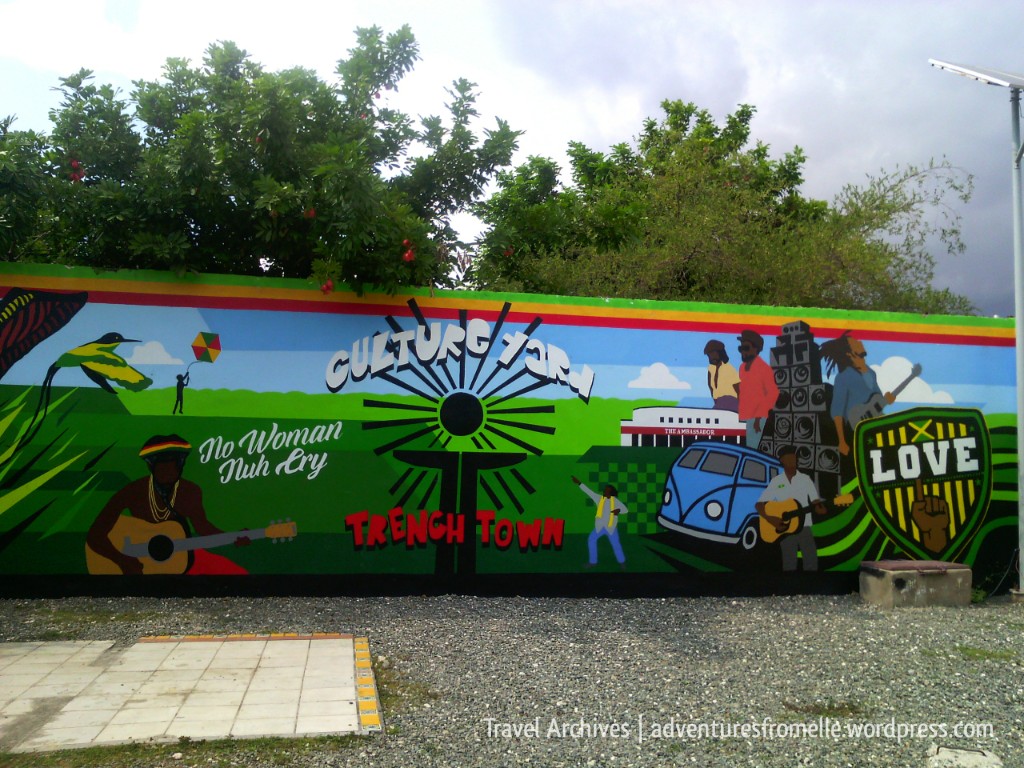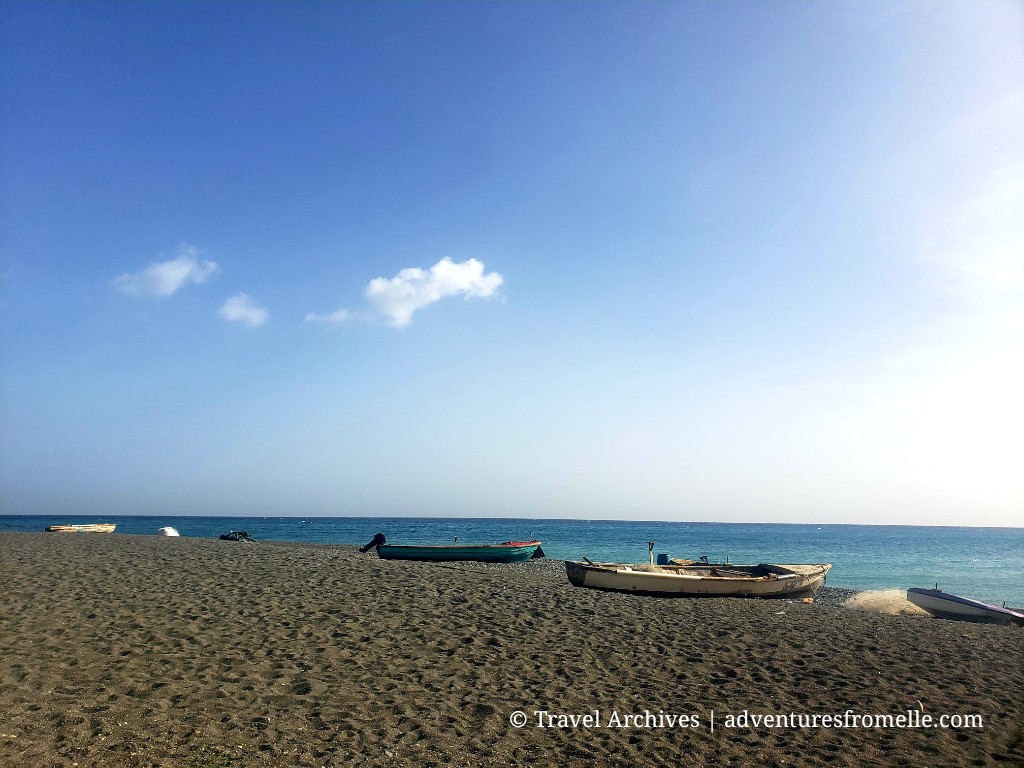Jamaica’s capital city of Kingston pulsates to the beat of reggae music and its raunchier cousin, dancehall music. Both genres originated here so opportunities to enjoy and learn about their origins in Kingston are endless. Bob Marley is indisputably the world’s most famous Rastafarian and reggae’s most celebrated son. Born in the rural district of Nine Miles, St. Ann, Kingston can’t take credit for his birthplace but it can for his rise to fame. Bob Marley and his immediate family relocated to Trench Town, Kingston at age 12 in search of a better life.

Before we get into the article, please subscribe for new adventures.
Also, please support the writer by purchasing her books on Amazon.

The Trench Town Culture Yard (TTCY) was opened on February 6, 2000 as a tribute to Bob Marley’s early home and was officially declared Jamaica’s first inner city National Heritage Site on May 10, 2007. TTCY gives insight into the humble beginnings which made Bob the man and stellar musician he was, unlike his museum and recording studio tours which document Bob’s life during and after the fame. Thus, a visit to the TTCY is important for anyone wanting a deeper understanding of Jamaica’s global icon and his legacy.
How to Find Trench Town Culture Yard

If you know anything about St. Andrew’s parish capital of Half-Way-Tree, you’ll know it’s filled with annoying one way roads. Thus, if you’re driving to the Culture Yard from there, look up which road(s) will get you onto Maxfield Avenue. It’s a fairly short stretch of road provided it’s not peak hour traffic and you’ll want to take a left turn onto Spanish Town Road when you get to the end of it. After you’ve passed the first or second left turns from Spanish Town Road, slow to avoid passing Collie Smith Drive. Collie Smith Drive is the third left turn off Spanish Town Road across from Kingston’s largest cemetery, the May Pen Cemetery. TTCY is located at 6-8 First Street, an appropriately named road in that it’s the first left turn from Collie Smith Drive. Thus, once you’re on Collie Smith Drive, you can’t miss First Street. Look out for the red, green and gold and maybe some Bob Marley street art or two. Parking is along the side of the road in front of TTCY. In terms of public transport, the only kind I’d recommend is a chartered taxi to and from. Only two routes from South Parade in Downtown go near here and they still leave you with a bit of walking in a community which is still plagued by violence ever so often.
They’re open everyday: 9am–6pm on Mondays to Fridays, 9am–8pm on Saturdays and 10am–6pm on Sundays. After stepping through the front gate (next to the wall pictured above), you’ll see a little courtyard. Ask anyone for the ticket office and they’ll point you to here:

You have three (3) tour options:
- The Culture Yard (Tour 1)– lasts 45+ minutes and costs US$12.00 (JA$800 for locals).
- Culture Yard + Short Community Tour (Tour 2)– lasts 60+ minutes and costs US$18.00 (JA$1,300 for locals).
- Culture Yard + Long Community Tour (Tour 3)– lasts 2 hours+ and costs US$30.00 (JA$2,300 for locals).
Walk-ins are welcome! I chose tour #1 and it started almost immediately. Facilities like restrooms, a lounge, Lion of Judah Courtyard and souvenir shop are available, as well as the Casbah Café and Bar for a quick drink or snack.

Trench Town Culture Yard (TTCY)

My guide for the afternoon goes by the nickname of ‘Blackie’ as he claims to be proud of his Black (African) heritage. We went from room to room which bore original photographs, newspaper snippings and other paraphernalia common to museums. Trench Town is a squatter settlement which gets its namesake from a wealthy Irishman by the surname of Trench who migrated to Jamaica in the 1700s in search of wealth. He owned a cattle ranch on what is now Trench Town, formerly known as Trench Pen since that’s what the land was– a large cattle pen. The land was poorly managed and over time it became government land. In 1937, a government agency by the name of Central Housing Authority (CHA) was established to create housing solutions for the rural poor, urban poor and ex-servicemen. The first residences were established between 1940 and 1949, and designed for communal living. These residences were known as Government or tenement Yards, arranged in four basic shapes–letters ‘H’, ‘S’, ‘T’ and ‘U’. The shape of the yard determined the resources available, with Bob’s yard, the ‘U’ block, having the least autonomy with the sharing of bathroom, toilet and kitchen facilities.


What struck me is the size of the rooms! They are 100 sq. ft. in size, smaller than what the average middle class family calls a bedroom today! Yet, this was (is) where families live(d). It’s incredibly humbling to see the original articles, instruments and furnishings used by Bob himself and other residents of that block who have also excelled and made names for themselves internationally. One of Bob’s earliest friends, teacher and mentor was Vincent “Tarta” Ford who shared his U-block residence. Living in abject poverty, much time was spent outdoors in the courtyard hanging out, socializing, eating, gambling and listening to music. Tarta would cook at a lot of these gatherings while George, another resident of this block, would make his famous cornmeal porridge over wood-fire which Bob alluded to in one of his earlier songs. It was during these down times that Tarta taught Bob how to play the guitar and even wrote the song ‘No Woman No Cry’ which has brought Bob much acclaim. It was also here that the band ‘the Wailers’ was formed between Bob, Peter Tosh and Bunny Wailer.

I wouldn’t be painting the story accurately if I put the focus solely on Bob. In the early days of the TTCY project, it was proposed that the venue should be named “Bob Marley Culture Yard.” However, stakeholders including his wife Rita Marley decided against this, citing that too many talents have arisen from the community for them to give Bob all the glory. Despite the poverty and later community tensions, warfare and crime which broke out in the 1970s onward, these government yards of Trench Town are seen as Jamaica’s Hollywood. To see my point, I must quote the TTCY brochure here: “Consider the following personalities that were connected to, were born or lived in Trench Town and the Government Yards; Alexander Bustamante, Norman Manley, Reverend Hugh Sherlock, St. William Grant, Mortimer Planno, Collie Smith, Alton Ellis, Delroy Wilson, Joe Higgs, Bob Marley, Peter Tosh, Bunny Wailer, Tony Spaulding, Leroy Sibbles, … , the Abyssinians, Junior Tucker, Shepherd Levi” and I could go on. Thus, it’s very honourable that this yard was restored to its original likeness and shares the history of the neighbourhood at large, telling their story as they see fit and rewriting the image crime and the media has painted for them.
The culture yard isn’t solely about Bob but we both know that’s the lure which attracts thousands annually. Thus, the TTCY owns a lot of Bob’s firsts. While his records, equipment, instruments, gifts and awards are housed at his official museum and recording studio, treasures like Bob’s first ever guitar and his first ever vehicle were left where they belong– at the TTCY where it all began. That being said, let’s enjoy the yard now, shall we?









Wrap Up
I love visiting places which have perfectly preserved the past and can tell a meaningful story which is still relevant today. That sums up my experience at the Trench Town Culture Yard– an authentic recollection of life in mid-1900s urban poor Jamaica with a knowledgeable guide and enough preserved treasures to make a 90 minute visit worth it. If your time in Kingston is limited and you only have enough time to visit one Marley destination, I’d recommend here. It’s the least glitzy and glamorous of the three but that’s fine. If the Culture Yard were glamourized and glitzed, it wouldn’t be authentic and that’s the appeal of the place. The best art comes out of the most deprived places and of the three Marley Kingston tours I’ve done, none gave me insight into his life the way the Culture Yard did. However, I rate TTCY four stars, ☆☆☆☆, a little less than his official museum and recording studio tours. That’s because I found the professionalism to be lacking in comparison. . . For example, the smellll of ganja eeeeeverywhere. That’s probably because I don’t smoke and didn’t appreciate taking shallow breaths nearly half the tour. I understand that smoking cannabis is one of the Rastafari sacraments so perhaps I shouldn’t complain but this didn’t happen on my previous tours, nor would it be a blog if I didn’t give my honest opinion. 🙃
Check out these other Bob Marley spots in Kingston:




- The official Bob Marley Museum at 56 Hope Road in Liguanea
- Tuff Gong Recording Studio at 220 Marcus Garvey Drive
- Cane River Falls, an off-the-beaten-path waterfall in Nine Miles, Bull Bay and Bob’s frequent hang out spot.
- Bob Marley Beach, another one of Bob Marley’s old stomping grounds.
Next stop on the reggae trail: Bob’s birthplace in Nine Miles perhaps? We’ll see.
‘Til next time. ✌🏼
Find Elle on Facebook, Pinterest, Instagram and now on YouTube.

Decision to change name from Bob Marley CY to Trench Town CY has nothing directly to do with Bob’s wife Rita. It was actually my suggestion that other stakeholders accepted. One
In the considerations was because of the sensitivity and legality around the Marley name. The other is the reality that the Trench Town storynis
Much bigger than Bob Marley. The Marley family were not and still aren’t a part of the establishing of the TTCY. In recent years however three of the sons , Stephen, Rohan and Damian have made financial and other contributions to the TTCY.
LikeLike
Hi Chris, thanks for reading and taking the time to leave a comment! All the factual statements I wrote were taken from the brochure, website and/or guide so if this is so, have them make some updates to the info they’re putting out for visitors. I certainly agree that Trench Town is much bigger than Bob Marley, a point I made sure not to leave out in writing. I was blown away at how many talents stemmed from the community.
LikeLike
Fascinating story! I had never heard any of this history. Makes Bob Marley’s songs even more meaningful for certain.
LikeLiked by 2 people
It really is! I marvel at what he managed to accomplish in just 36 years, not to mention the great legacy he left behind for his sons. As his son Damian Marley puts it, because of the foundation he left they are able to “live it up”.
LikeLiked by 1 person